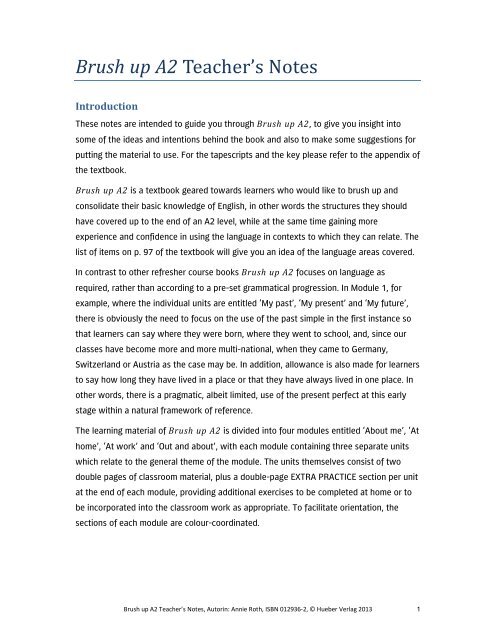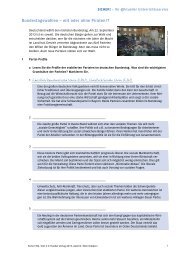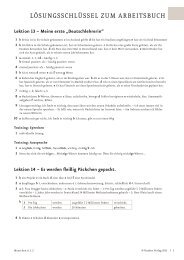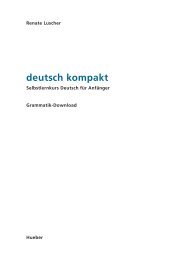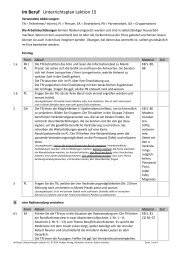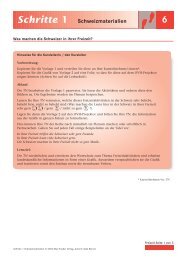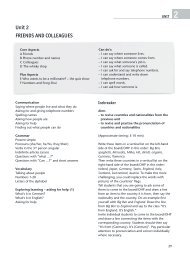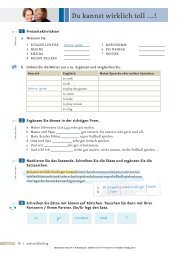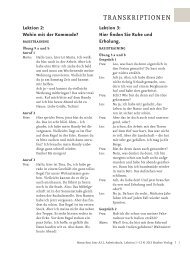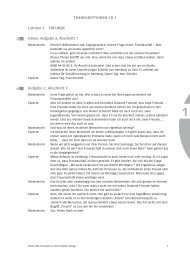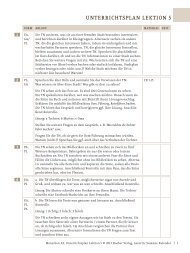Create successful ePaper yourself
Turn your PDF publications into a flip-book with our unique Google optimized e-Paper software.
<strong>Brush</strong> <strong>up</strong> <strong>A2</strong> Teacher’s <strong>Notes</strong><br />
Introduction<br />
These notes are intended to guide you through <strong>Brush</strong> <strong>up</strong> <strong>A2</strong>, to give you insight into<br />
some of the ideas and intentions behind the book and also to make some suggestions for<br />
putting the material to use. For the tapescripts and the key please refer to the appendix of<br />
the textbook.<br />
<strong>Brush</strong> <strong>up</strong> <strong>A2</strong> is a textbook geared towards learners who would like to brush <strong>up</strong> and<br />
consolidate their basic knowledge of English, in other words the structures they should<br />
have covered <strong>up</strong> to the end of an <strong>A2</strong> level, while at the same time gaining more<br />
experience and confidence in using the language in contexts to which they can relate. The<br />
list of items on p. 97 of the textbook will give you an idea of the language areas covered.<br />
In contrast to other refresher course books <strong>Brush</strong> <strong>up</strong> <strong>A2</strong> focuses on language as<br />
required, rather than according to a pre-set grammatical progression. In Module 1, for<br />
example, where the individual units are entitled ‘My past’, ‘My present’ and ‘My future’,<br />
there is obviously the need to focus on the use of the past simple in the first instance so<br />
that learners can say where they were born, where they went to school, and, since our<br />
classes have become more and more multi-national, when they came to Germany,<br />
Switzerland or Austria as the case may be. In addition, allowance is also made for learners<br />
to say how long they have lived in a place or that they have always lived in one place. In<br />
other words, there is a pragmatic, albeit limited, use of the present perfect at this early<br />
stage within a natural framework of reference.<br />
The learning material of <strong>Brush</strong> <strong>up</strong> <strong>A2</strong> is divided into four modules entitled ‘About me’, ‘At<br />
home’, ‘At work’ and ‘Out and about’, with each module containing three separate units<br />
which relate to the general theme of the module. The units themselves consist of two<br />
double pages of classroom material, plus a double-page EXTRA PRACTICE section per unit<br />
at the end of each module, providing additional exercises to be completed at home or to<br />
be incorporated into the classroom work as appropriate. To facilitate orientation, the<br />
sections of each module are colour-coordinated.<br />
<strong>Brush</strong> <strong>up</strong> <strong>A2</strong> Teacher’s <strong>Notes</strong>, Autorin: Annie Roth, ISBN 012936-2, © <strong>Hueber</strong> Verlag 2013 1
In addition, each module is rounded off by the following regular features:<br />
• FOCUS ON READING, providing an extensive reading text relating to the topic of<br />
the module and incorporating structures and vocabulary from that module. The<br />
basic idea is to encourage learners to read for pleasure, and so the reading text is<br />
intended to be read at home (any additional vocabulary can be found in the word<br />
list at the back of the book). However, it can also be used as a basis for a follow<strong>up</strong><br />
discussion in class since each text finishes with either a direct or indirect<br />
question being put to the reader. Take, for example, the text on p. 70 which ends<br />
with the question ‘So what do you think? Have I finally found my job for life?’ After<br />
having read the text at home, learners can then discuss their views in the next<br />
lesson in small gro<strong>up</strong>s before presenting their thoughts to the class at large. Allow<br />
for some free exchange of ideas without too much correction.<br />
• FOCUS ON LANGUAGE, highlighting selected items of functional and topic-based<br />
language from each module as well as useful expressions, which could be termed<br />
items of ‘sparkly’ English like ‘Well, that’s the theory.’ on p. 12. In addition, space<br />
is provided for learners to add any additional expressions from the module that<br />
they particularly like and want to remember. This emphasizes the element of<br />
personalization in language-learning since we all have our own linguistic<br />
preferences.<br />
• ONE-MINUTE TALK, whereby learners are invited to prepare a one-minute talk on a<br />
given topic for the following lesson. Since the talk is based on the topics and<br />
language of each module, learners are given an additional opportunity to review<br />
what they have worked on in the past three units and bring it all together in an<br />
area of personal reference. They are reminded to check in particular the verb forms<br />
and the use of prepositions in their script and are referred to the Language<br />
Overview section at the back of the book. The intention here is to point learners in<br />
the right direction on the one hand while at the same time handing over some of<br />
the responsibility to them. They are, after all, adult learners.<br />
• TRACK YOUR PROGRESS, giving learners the chance to review their own progress<br />
with regards to the language functions contained in each module and to award<br />
themselves the appropriate smileys:<br />
☺ ‘I feel quite happy about this item.’<br />
‘I think I’m OK with this item.’<br />
☹ ‘I’m not so sure about this item.’<br />
<strong>Brush</strong> <strong>up</strong> <strong>A2</strong> Teacher’s <strong>Notes</strong>, Autorin: Annie Roth, ISBN 012936-2, © <strong>Hueber</strong> Verlag 2013 2
By counting their score, learners can form their own personal estimation of<br />
whether they feel the need to look back at certain items of the module before<br />
moving on. Here again the emphasis is on personalization and on taking on<br />
responsibility.<br />
Within the units there are also a number of regular features to be found:<br />
• USEFUL EXPRESSIONS boxes, which draw the learners’ attention to items of real<br />
English which have come <strong>up</strong> in a natural context or perhaps some functional<br />
language and which offer them the possibility of adding these to their active<br />
vocabulary if they wish.<br />
• MY LANGUAGE BOX, providing items of functional language which learners can put<br />
into direct use when doing the appropriate exercises.<br />
• REMEMBER boxes, since it is after all a refresher course, focusing on specific<br />
structures or grammatical items which the learners should have had in the past. In<br />
addition, there is a cross reference to the Language Overview section at the back<br />
of the book, where learners will find a detailed overview of the usage and forms of<br />
the relevant structures.<br />
• The flag symbols are used to point out differences in British and<br />
American English where appropriate.<br />
• In addition, there is a mini Quiz Time in each unit which can have a structural<br />
or lexical focus, can be used for reading comprehension or simply as a quiz<br />
question like the one on p. 41.<br />
Take a little bit of time to point out to learners what they can find in the book since it is<br />
one of the vital tools in their learning process. The Appendix contains<br />
• an overview of the structures covered in the book (pp. 97 ff.),<br />
• a table of irregular verbs as appropriate for an <strong>A2</strong> level (p. 112),<br />
• the tapescripts (pp. 113 ff.),<br />
• the key to all exercises (pp. 120 ff.), allowing learners to check their homework<br />
before coming to the next lesson and therefore saving valuable classroom time –<br />
however, do allow for any questions which may have arisen,<br />
• a chronological list of vocabulary unit by unit together with the phonetic<br />
transcriptions and German translations, focusing in particular on chunks of<br />
language (pp. 128 ff.),<br />
<strong>Brush</strong> <strong>up</strong> <strong>A2</strong> Teacher’s <strong>Notes</strong>, Autorin: Annie Roth, ISBN 012936-2, © <strong>Hueber</strong> Verlag 2013 3
• an alphabetical word list featuring the Macmillan English Dictionary three-star<br />
system (pp. 143 ff.) and<br />
• a list of classroom language (p. 149).<br />
And, of course, there is also the audio CD containing all the listening texts so that learners<br />
can listen to them at their leisure.<br />
For those learners who would like to document their learning progress with a language<br />
certificate there is the choice of taking the Cambridge English: Key (KET) exam or another<br />
exam at <strong>A2</strong> level. Some Volkshochschulen also offer integrated exam courses. In any case,<br />
we wish you and your learners an enjoyable and successful teaching and learning<br />
experience with <strong>Brush</strong> <strong>up</strong> <strong>A2</strong>.<br />
Module 1 About me<br />
Unit 1 My past<br />
The first unit deliberately starts by focusing on the past because we all have a past before<br />
we have a present, and, in an era of mobility, people don’t necessarily live all their lives in<br />
the same place they were born and grew <strong>up</strong> in. (See also the notes in the 3 rd paragraph of<br />
the general introduction.)<br />
Lead-in: After a general round of ‘Hello’ and ‘How are you?’ and ‘What’s your name?’ try<br />
the following activity to get learners <strong>up</strong> on their feet and to sensitize them for the opening<br />
of the unit, which is intended to show that people have different biographies.<br />
Ask learners to listen carefully and then to stand <strong>up</strong> as appropriate.<br />
‘Stand <strong>up</strong> all those who were born in (name of location).’ ‘Sit down, please.’<br />
‘Stand <strong>up</strong> all those who live in (name of location).’ ‘Sit down, please.’<br />
‘Stand <strong>up</strong> all those who have always lived in (name of location).’ ‘Sit down, please.’<br />
‘Stand <strong>up</strong> all those who were born somewhere else … and now live in (name of location).’<br />
‘Sit down, please.’<br />
‘Stand <strong>up</strong> all those who have lived in more than one place.’ ‘Sit down, please.’<br />
Ask learners what they noticed. → Different people stood <strong>up</strong> at different times.<br />
<strong>Brush</strong> <strong>up</strong> <strong>A2</strong> Teacher’s <strong>Notes</strong>, Autorin: Annie Roth, ISBN 012936-2, © <strong>Hueber</strong> Verlag 2013 4
1a Listening and reading at this initial stage of the course gives learners more security.<br />
This is the only example of this type of task in the book. However, if you would like to<br />
make more use of the listen-and-read technique, you could ask your students to look at<br />
the tapescript while listening to the recording after they have completed the listening task<br />
set out for them. Alternatively, you could encourage them to make use of the tapescripts<br />
by listening and reading at home.<br />
2a Encourage learners to make use of the language input in texts by adopting a system of<br />
highlighting, underlining or circling for useful expressions or chunks of language that they<br />
want to put to use. Different people will adopt different systems.<br />
2b This task focuses on the skill of note-taking while listening before leading on to the<br />
next exercise where these notes will form the basis of full sentences. In other words, it’s a<br />
mini dictogloss exercise (an exercise where only key words are noted in contrast to a<br />
dictation where every word is written down).<br />
3a/b REMEMBER box: Look at the Language Overview section on pp. 100–102 to<br />
introduce your learners to this section of the book. All tenses are presented showing their<br />
usage and their form. The boxes on the right-hand side contain a variety of tips to make it<br />
easier for learners to retain useful information more easily.<br />
3b The adverbial of time structure ‘for … months/years’ can be used with both simple<br />
past and present perfect, depending on the time aspect. To avoid unnecessary confusion<br />
the ‘since …’ structure has been omitted here. This will be dealt with at the B1 level.<br />
3c REMEMBER box: Depending on the gro<strong>up</strong> you are teaching you may want to look at<br />
the Language Overview section together with the learners again or leave it <strong>up</strong> to them to<br />
do so. In any case, impress <strong>up</strong>on your learners how important it is to learn the usage of<br />
prepositions in context.<br />
Quiz Time is used here to create an awareness of the difference in use between simple<br />
past and present perfect. Ask learners how they know what the correct answer is. The<br />
clue is, of course, ‘has lived’ in sentence 10.<br />
4b Elicit two examples from learners before they start their little discussion.<br />
‘I think this is a good way to learn because you can …’<br />
‘I don’t think this is a good way to learn because you can’t …’<br />
<strong>Brush</strong> <strong>up</strong> <strong>A2</strong> Teacher’s <strong>Notes</strong>, Autorin: Annie Roth, ISBN 012936-2, © <strong>Hueber</strong> Verlag 2013 5
5a Always allow for different possibilities as long as they make sense.<br />
5c The information cards in the Files section (pp. 95 + 96) contain a different number of<br />
pieces of information. Sabine’s card on p. 95 and Maria’s on p. 96 both contain four pieces<br />
of info, whereas the others only contain two. With Zoltán and Marcus learners have to<br />
think of some more information. Depending on the gro<strong>up</strong> you have, you could suggest<br />
that everyone starts with an easy card and then moves on to the more demanding one or<br />
you could leave it <strong>up</strong> to the learners to decide.<br />
EXTRA PRACTICE (pp. 20–21)<br />
2/3 Not all units have a listening exercise in the EXTRA PRACTICE section, only Units 1, 4<br />
and 10. Encourage learners to listen to these recordings a number of times at home,<br />
primarily without looking at the tapescripts.<br />
7 A regular feature of the EXTRA PRACTICE section is the preparation of some material<br />
which can provide learner input in the next lesson.<br />
Unit 2 My present<br />
This unit starts off by focusing on everyday routines based on a family where the woman<br />
goes out to work and the man works from home and also acts as the house husband.<br />
1a Asking learners to guess something before reading a text (or listening to a recording,<br />
as the case may be) is highly motivational as they will be keen to find out whether their<br />
guess was right.<br />
Quiz Time is used here to ascertain whether learners have understood the implication of<br />
the idiomatic expression ‘Well, that’s the theory.’<br />
2a/b There is a grammar and a vocabulary focus here: 1 st and 3 rd person singular forms of<br />
the present simple; collocations with ‘do’ and ‘make’. Encourage learners to get used to<br />
the idea of what goes with what, in this case which nouns collocate with which verbs as<br />
this will help them to store and retrieve their vocabulary more effectively.<br />
3a Learners can also complete the mind maps in their textbooks if they wish, but writing<br />
the household jobs in conjunction with the time expressions in their notebooks can help<br />
them to anchor these in their memories. You could then ask them to close their notebooks<br />
once they have completed this task and then ask them to tell you, e.g., which household<br />
jobs they do every day from memory.<br />
<strong>Brush</strong> <strong>up</strong> <strong>A2</strong> Teacher’s <strong>Notes</strong>, Autorin: Annie Roth, ISBN 012936-2, © <strong>Hueber</strong> Verlag 2013 6
3b Encourage learners to get <strong>up</strong> from their seats and mix and mingle. On the one hand it’s<br />
more interesting than just talking to the person sitting next to you all the time, and it also<br />
provides an opportunity for repetition. Apart from that, it prevents learners clinging to a<br />
‘safety blanket’ and prepares them for using English in the real world, which should<br />
always be our main objective.<br />
4a In this listening exercise learners will not hear Victoria on the other end of the phone<br />
line and so will have to infer the answers to questions 1 and 2 from what Peter says.<br />
Again this reflects on a real-life situation where we often only hear one side of a<br />
telephone conversation and then try to infer what the other person has said.<br />
5a Although the instructions say ‘Listen to the dialogue again’, what is meant, of course,<br />
is the one-sided phone call.<br />
4c–5e These exercises pick <strong>up</strong> on the situation in 4a/b where Peter asks Victoria for help,<br />
and she has to turn him down. Learners are then given the opportunity to say ‘Yes’ or ‘No’<br />
when asked for help. The reference to the structure ‘Could you …?’ when asking for help<br />
can be found on p. 105 (1.10.2).<br />
6a This is the first of a number of ‘Find someone who …’ activities in the book where<br />
learners have to mix and mingle with the objective of finding someone who can answer<br />
‘Yes’ to their question. In this first instance (and perhaps also in some of the later ones)<br />
you might want to remind learners of the question forms they should be using: in this case<br />
‘Do you …?’ and ‘Are you …?’ When learners have found someone who answers ‘Yes’ to<br />
one of their questions, they should write down the name of that person and then move on<br />
to someone else. Make sure they don’t stick with one partner all the time!<br />
6c Allow for some free exchange of opinions here with as little correction as possible.<br />
However, encourage learners to make use of as many of the useful expressions as<br />
possible.<br />
EXTRA PRACTICE (pp. 22–23)<br />
4 Allow for learners to present their sentences in class or to exchange their versions in<br />
small gro<strong>up</strong>s.<br />
6 Depending on the gro<strong>up</strong> you are teaching, you could make use of this learner input to<br />
provide an additional class activity based on asking for help and the expressions in 4c/<br />
p. 14.<br />
<strong>Brush</strong> <strong>up</strong> <strong>A2</strong> Teacher’s <strong>Notes</strong>, Autorin: Annie Roth, ISBN 012936-2, © <strong>Hueber</strong> Verlag 2013 7
Unit 3 My future<br />
This unit focuses on two important structures used to talk about the future: the ‘going tofuture’<br />
for talking about resolutions and intentions and the present continuous for talking<br />
about future arrangements. The future reference is then rounded off with a brief focus on<br />
the ‘will-future’ to express a promise, an offer of help or a spontaneous decision. This has<br />
been done deliberately in order to impress on learners that the ‘will-future’ is not<br />
necessarily the most important or the most common way of expressing the future.<br />
1 This exercise can be done no matter what time of the year it is, especially since<br />
resolutions to improve one’s lifestyle are a common topic in today’s day and age.<br />
2a Again you can ask learners to complete this in their notebooks and then proceed as in<br />
Unit 2/3a.<br />
2b You might want to elicit some possible collocations from your learners before they<br />
complete this exercise.<br />
Quiz Time is used here to help learners realize that by saying ‘Neither am I’ you are<br />
actually agreeing with what someone else says.<br />
3a Allow for different combinations here as long as they make sense.<br />
3b This exercise allows learners to recycle what they have written in 2b, but this time<br />
adding a reason to each resolution. They could refer to 3a or think of their own reasons as<br />
appropriate.<br />
4/5 These exercises have been chosen in order to show learners that in contrast to what<br />
they have been doing in parts 1–3 of this unit, they are now talking about definite<br />
situations for which arrangements have been made as in a dentist’s appointment or a<br />
lunch-date.<br />
5a Make sure that learners are sure of the correct question form in this exercise: ‘Are you<br />
…ing …?’ See also note on Unit 2/6a.<br />
5b REMEMBER box: Refer learners to the second paragraph in the section on prepositions<br />
on p. 110. At the same time point out the difference in the usage of ‘at/on the weekend’<br />
between British and American English.<br />
7 Again allow for different possibilities as long as they make sense. At the same time<br />
encourage learners to look for clues to help them make good matches. This is a strategy<br />
which will come in useful again and again at all levels of learning. Make sure that learners<br />
<strong>Brush</strong> <strong>up</strong> <strong>A2</strong> Teacher’s <strong>Notes</strong>, Autorin: Annie Roth, ISBN 012936-2, © <strong>Hueber</strong> Verlag 2013 8
pronounce ‘info’ as in /'ɪnfəʊ/ whereas ‘asap’ is an acronym for ‘as soon as possible’ and<br />
as such is pronounced ASAP /ˌeɪ es eɪ ˈpiː/.<br />
EXTRA PRACTICE (pp. 24–25)<br />
Exercises 5 + 7 can also provide learner input at the next course meeting.<br />
FOCUS ON READING (p. 26)<br />
See the FOCUS ON READING section in the introduction. The bare framework of this little<br />
story is biographical. There is a Solveig who was born in Denmark and grew <strong>up</strong> in South<br />
Africa, is married to a Frenchman and has spent most of her married life in Germany; but<br />
that’s about it. The rest is fiction.<br />
FOCUS ON LANGUAGE (p. 27)<br />
Take time to point out this section to learners and encourage them to add any other<br />
language items from the module which they would like to store in their personal word<br />
banks.<br />
ONE-MINUTE TALK (p. 28)<br />
See the ONE-MINUTE TALK section in the introduction. This activity is intended to be<br />
prepared at home, and learners should allow some time for it in order to collect their<br />
ideas, prepare their talk, check their language – and, of course, time themselves to one<br />
minute. By restricting it to one minute, you can allow for everyone to give their mini-talk<br />
in class. Invite students to present their talk from the front of the class while you take a<br />
seat with the others, making notes as you wish. If you do want to pass on any corrections<br />
or suggestions, then it would be a good idea to collect these and go over them once all<br />
the presentations are complete, as some errors may repeat themselves.<br />
TRACK YOUR PROGRESS (p. 28)<br />
See the TRACK YOUR PROGRESS section in the introduction. This is intended as a very<br />
individual and personal activity to be carried out by each learner at home. Feedback<br />
should be restricted to learners asking for suggestions of what to do if they are still<br />
uncertain about one or more of the points in the list. If you feel the general need to go<br />
over a particular aspect of the module, then by all means do so before going on to the<br />
next module.<br />
<strong>Brush</strong> <strong>up</strong> <strong>A2</strong> Teacher’s <strong>Notes</strong>, Autorin: Annie Roth, ISBN 012936-2, © <strong>Hueber</strong> Verlag 2013 9
Module 2 At home<br />
Unit 4 Where I live<br />
This unit takes <strong>up</strong> the use of the present simple again to allow learners to talk about<br />
where they and other people live. Fitting into the topic are the structures ‘there is/are’,<br />
prepositions and adverbials of place, personal pronouns and possessive determiners as<br />
well as a brief section on ‘some/any’.<br />
1a This reading exercise could be given as a preparatory homework exercise to save time<br />
in class, or it could be turned into a gro<strong>up</strong> activity where each person in a gro<strong>up</strong> of four is<br />
allotted one text to read silently and decide on the matching picture on p. 31. They are<br />
also responsible for checking on the vocabulary of their text. When everyone is ready, the<br />
texts are read out within the gro<strong>up</strong>s, explanations are given as necessary, and the others<br />
are then asked to decide which is the matching picture. Here again there is the<br />
opportunity of practising some learner autonomy. However, since the texts are not all of<br />
equal length, you could allot them according to weaker and stronger students in the<br />
gro<strong>up</strong>. With gro<strong>up</strong>s of three, one learner could take texts 2 + 4.<br />
Quiz Time refers to the list in 1b and focuses on lexical understanding.<br />
1f Allow for a few minutes of preparation and then ask learners to present their minitexts.<br />
Alternatively, you could make a guessing activity out of this, whereby learners put<br />
their texts in a bag and one by one each learner draws a paper, reads it out and the class<br />
has to guess whose home is being described.<br />
2a/b This listening text contains a number of details, and ideally learners should hear it<br />
three times. Again the guessing function of 2a acts as a strong motivator, and while<br />
listening to check whether they guessed correctly, learners are already soaking <strong>up</strong> some<br />
of the details. Before listening for the second time learners could try to complete as much<br />
of 2b as they can and then listen to check. At this point they could compare their floor<br />
plans with a partner and then listen for a third time to clear any uncertainties.<br />
To anchor the use of the prepositions and adverbials in the REMEMBER box with a game<br />
throw a soft ball to one of the learners and ask ‘Where’s the kitchen?’ After answering,<br />
that person throws the ball to someone else and asks another question, and so on.<br />
2c Point out to learners that they don’t have to be Rembrandt (or Picasso) to complete<br />
the drawing. It’s a fun exercise focusing on personalization. When monitoring, make sure<br />
learners are using the structures in the REMEMBER box.<br />
<strong>Brush</strong> <strong>up</strong> <strong>A2</strong> Teacher’s <strong>Notes</strong>, Autorin: Annie Roth, ISBN 012936-2, © <strong>Hueber</strong> Verlag 2013 10
EXTRA PRACTICE (pp. 42–43)<br />
Exercises 4+5 provide some learner input for the next lesson.<br />
Unit 5 My neighbours<br />
The first part of this unit focuses on the comparative use of the present perfect and the<br />
simple past.<br />
2a With the first dialogue allow for a different order of the questions, whereas with the<br />
second one there really is only one logical sequence of questions as given in the key.<br />
However, there is really only one matching answer to each question.<br />
The first dialogue provides a good example of switching from the present perfect to the<br />
simple past once it has been established that something has taken place and you now<br />
want more information about that specific event in the past.<br />
3b Always encourage learners to add their own ideas to exercise material where<br />
appropriate, as here.<br />
3c This exercise provides good practice of switching from the present perfect to the<br />
simple past. (See 2a above.) An extra tip for your learners: the preposition ‘to’ follows<br />
‘been’, but not ‘was’ or ‘were’ → ‘I’ve been to New York.’ (‘I was in New York.’)<br />
3a/b/c REMEMBER box: take some time to look at the appropriate section of the<br />
Language Overview together with the learners (pp. 100 ff.).<br />
4a Here the focus changes to word families, with a fun-like repetition in 4b also providing<br />
some useful recycling of the going to-future.<br />
5a Again allow for two listenings with a short comparing phase in between.<br />
Quiz Time is intended to arouse an awareness of more or less formal greetings.<br />
5c Make sure learners are introducing their partners to the others and not themselves!<br />
EXTRA PRACTICE (pp. 44–45)<br />
Exercises 3+4 again provide some learner input for the next lesson.<br />
Exercise 8 (focusing on ‘they’re’/’their’/’there’) is worth taking a look at in class.<br />
<strong>Brush</strong> <strong>up</strong> <strong>A2</strong> Teacher’s <strong>Notes</strong>, Autorin: Annie Roth, ISBN 012936-2, © <strong>Hueber</strong> Verlag 2013 11
Unit 6 My free time<br />
The topic of this unit lends itself to revising verbs followed by -ing and also the present<br />
simple with adverbials of frequency.<br />
As a lead-in you could refer to the photo and ask learners what this lady likes doing.<br />
→ ‘She likes reading/relaxing/sunbathing/…’<br />
1a/b/c These exercises then give learners the opportunity to talk about what they<br />
like/enjoy/prefer doing in their free time and how they spend their free time.<br />
2a These two short texts, based on surveys found on the web, focus on how much time<br />
Americans and Nova Scotians spend on activities such as watching television, socializing,<br />
etc. and prepare students for the personalization activities in 3a/b.<br />
Check that learners understand the key words before they read the texts. The follow-<strong>up</strong><br />
exercise also includes a ‘possible’ option with statement no. 5 since the text doesn’t<br />
contain this precise information and so we don’t know whether it’s true or false.<br />
3b While monitoring make sure that learners are using the structure ‘I spend ... a day<br />
…ing.’<br />
4a/b Allow enough time for these two activities so that learners have the chance to talk<br />
to everyone else in the class if possible. After all, the objective is to produce a class<br />
survey, which would then link <strong>up</strong> with the input texts in 2a.<br />
5a This is a slightly different ‘Find someone who …’ exercise in that learners are trying to<br />
find positive and negative answers.<br />
6a This listening exercise is based on interviews carried out with people in the street. The<br />
first and the third interviewees (Roddy and Liz) are quite laid-back about being<br />
interviewed whereas the second person only agrees to being interviewed if it’s<br />
anonymous.<br />
7a/b These exercises focus on some more unusual free-time activities. Perhaps some of<br />
your learners have already tried or know someone who has tried one or other of these<br />
activities. Allow for some learner input here.<br />
Quiz Time here is the only example of a real ‘quiz question’.<br />
<strong>Brush</strong> <strong>up</strong> <strong>A2</strong> Teacher’s <strong>Notes</strong>, Autorin: Annie Roth, ISBN 012936-2, © <strong>Hueber</strong> Verlag 2013 12
EXTRA PRACTICE (pp. 46–47)<br />
Exercises 5+9 again provide some learner input for the next lesson.<br />
Exercise 6 could also provide some follow-<strong>up</strong> practice of question forms in class if you<br />
think the particular gro<strong>up</strong> you’re teaching could benefit from this. Learners then ask<br />
others questions like ‘What do you prefer doing in summer?’, ‘What don’t you like doing<br />
in winter?’, etc.<br />
FOCUS ON READING (p. 48)<br />
See the FOCUS ON READING section in the introduction. This time there is an indirect<br />
question put at the end of the reading text as to what the writer’s Swiss neighbour will<br />
bring to the street party, also allowing for an exchange of ideas in the next lesson.<br />
FOCUS ON LANGUAGE (p. 49)<br />
See the FOCUS ON LANGUAGE section in the introduction.<br />
ONE-MINUTE TALK (p. 50)<br />
See the ONE-MINUTE TALK section in the introduction and at the end of Module 1.<br />
TRACK YOUR PROGRESS (p. 50)<br />
See the TRACK YOUR PROGRESS section in the introduction.<br />
Module 3 At work<br />
This module, as the name implies, revolves around the work situation of the learners.<br />
However, we are aware that not all learners will currently be in a work situation, and due<br />
allowance has been made for this, especially in the personalization tasks.<br />
Unit 7 My work<br />
This unit focuses on a variety of jobs, particularly from the viewpoint of whether these are<br />
‘jobs for life’, and so allows for some recycling of the simple present and the present<br />
perfect while at the same time revising the ‘used to’ structure.<br />
Lead-in: As a gro<strong>up</strong> exercise and with books closed learners do some brainstorming of<br />
English job-names – only the ones they know. (Don’t be caught <strong>up</strong> in the trap of having to<br />
rack your brains for the English version of something like ‘kaufmännische Angestellte im<br />
Außenhandelsbetrieb’! It doesn’t exist.) Collect the job-names on the board and limit the<br />
<strong>Brush</strong> <strong>up</strong> <strong>A2</strong> Teacher’s <strong>Notes</strong>, Autorin: Annie Roth, ISBN 012936-2, © <strong>Hueber</strong> Verlag 2013 13
time to one minute. Alternatively, learners can do this individually and note down <strong>up</strong> to<br />
ten job-names they can think of. In either case then compare with 1a to see how many of<br />
these five job-names came <strong>up</strong>. Learners can continue to compare with their lists as the<br />
unit contains a lot more than just these five.<br />
1b The roles in this role-play are equally divided.<br />
1c/d Learners have the chance to guess whether these five people have a job for life just<br />
by looking at the photos and discussing with a partner before confirming with the text of<br />
the magazine article. They should then go on to read the article text by text, looking for<br />
clues as to whether their guesses were right or wrong and deciding on the result before<br />
going on to the next text. It’ll be interesting to see how many people recognize Jamie!<br />
Quiz Time focuses on lexical understanding here.<br />
2a Since some learners probably don’t have such a good recollection of the structure<br />
‘used to’, first refer back to the texts in 1d and ask learners to find examples of ‘used to’.<br />
(Each text except the one about Tony contains an example.) Put the four examples <strong>up</strong> on<br />
the board and ask learners whether Emily, Fred, Amanda and Jamie still do these things.<br />
In this exercise learners should again be looking for clues to help them decide which<br />
structure is appropriate, e.g. in sentence 1 ‘and still enjoys’ is a clue, whereas in sentences<br />
2+3 it’s ‘but’.<br />
2b This exercise allows for learners being in completely different situations (retired,<br />
between jobs, on maternity leave, etc.) and gives everyone the chance to talk about what<br />
they do now or what they used to do.<br />
3c Here learners have the chance to modify opinions by agreeing, but not agreeing<br />
completely.<br />
3d Encourage learners to answer not just with ‘Yes, I would.’ or ‘No, I wouldn’t.’ but to<br />
expand on that by giving a reason. Refer them to 3b if necessary and also to the cartoon<br />
at the bottom of the page. Fun answers are also allowed!<br />
EXTRA PRACTICE (pp. 64–65)<br />
Exercises 2+5 again provide learner-generated material for the next lesson.<br />
<strong>Brush</strong> <strong>up</strong> <strong>A2</strong> Teacher’s <strong>Notes</strong>, Autorin: Annie Roth, ISBN 012936-2, © <strong>Hueber</strong> Verlag 2013 14
Unit 8 My working day<br />
The topic of this unit allows for a revision of times and nationalities while providing some<br />
practice of email reading and writing as well as some telephone talk.<br />
1a Allow for more than one possibility with speakers 1–3.<br />
1d Just like in Unit 7/2b, learners who are no longer in a working situation are not<br />
neglected but are given the chance to talk about their past working days. Remind them in<br />
this case to make use of the ‘used to’ structure (Unit 7/p. 54) when talking about<br />
something they did regularly in the past. It’s perhaps a good idea to replay the listening<br />
from 1a first.<br />
1e Here learners have to infer from the situations whether it’s ‘am’ or ‘pm’, e.g., message<br />
no. 5 is not likely to be 8pm! There will be another focus on times in Unit 10/p. 77 with<br />
the additional comparison between BE and AE usage.<br />
2a This survey was taken from the Internet, and it may surprise learners that Finland has<br />
the shortest working week and Romania the longest.<br />
3a/b The email from Tom to Alec, whom he hasn’t seen for a while, allows for a natural<br />
use of the present continuous to ask and tell somebody about current situations. (The<br />
present continuous can also be used like this in a face-to-face meeting.) To complete the<br />
two sentences learners have to find equivalent expressions in the text or make<br />
deductions.<br />
‘Cheers’ is a very common informal expression for ‘Bye’ and even ‘Thanks’.<br />
3c Make sure that learners don’t try to modify a verb with ‘very’. ‘Really’ can precede a<br />
verb or an adjective, but ‘very’ can’t precede a verb.<br />
Quiz Time focuses on reading comprehension here.<br />
3f Refer learners to the Language Overview section on p. 99 and point out that the<br />
present continuous is not used with the verbs ‘like’, ‘love’, ‘hate’ and ‘need’.<br />
3g You can make this into a mini-competition by dividing the gro<strong>up</strong> into two teams and<br />
awarding points. First decide on the maximum number of guesses. If the guessing team<br />
gets it within the maximum number of guesses, they gain a point; if not, the point goes to<br />
the miming team.<br />
<strong>Brush</strong> <strong>up</strong> <strong>A2</strong> Teacher’s <strong>Notes</strong>, Autorin: Annie Roth, ISBN 012936-2, © <strong>Hueber</strong> Verlag 2013 15
EXTRA PRACTICE (pp. 66–67)<br />
Exercise 2 again provides some learner input for the next lesson. It also gives learners the<br />
chance to do some ‘reading out loud’.<br />
Exercise 6 provides a learner-generated guessing activity for the next lesson.<br />
Unit 9 My new job<br />
The job profiles in the first part of the unit allow for a natural usage of the modal verbs<br />
‘have to’ and ‘don’t have to’. This leads on to the use of ‘mustn’t’ and ‘can’ as to be found<br />
in guidelines.<br />
1a A Jobcentre is a government-run office where vacancies are advertised and jobseekers<br />
can get help. A job club is more informal and a place where job-seekers can<br />
practise writing applications and CVs or practise doing job interviews (as in the film ‘The<br />
Full Monty’/“Ganz oder gar nicht”).<br />
1c While reading the extract from the website for the first time, learners should give each<br />
job offer their personal ‘Yes’, ‘No’ or ‘Maybe’. Most of the new words and expressions are<br />
contained in the matching exercise at the top of p. 61. Other expressions like ‘excellent<br />
communication skills’ should be understood. Otherwise, learners can look <strong>up</strong> the<br />
alphabetical wordlist in the Appendix, where they’ll find ‘skill’ on p. 147.<br />
1e Again, learners who are not currently in a working-situation are not left out. This time<br />
they can think of a job or look at Unit 7 for some ideas.<br />
1f While monitoring, make sure learners are using the ‘Do you have to …?’ structure and<br />
not just ‘Do you …?’<br />
2a Learners should give reasons for their choices by matching the candidate profiles with<br />
the job profiles on p. 60. Encourage them to look <strong>up</strong> only the key words necessary for<br />
their understanding.<br />
2b/c Learners should also use the listening as checking references. In 2c they could<br />
compare their answers with a partner after the first listening and then at the second<br />
listening concentrate on any questions they’re still not absolutely sure about.<br />
2d There are no correct answers here. Learners can discuss and decide among<br />
themselves.<br />
Quiz Time should hopefully make the difference between ‘don’t have to’ and ‘mustn’t’<br />
really clear to learners.<br />
<strong>Brush</strong> <strong>up</strong> <strong>A2</strong> Teacher’s <strong>Notes</strong>, Autorin: Annie Roth, ISBN 012936-2, © <strong>Hueber</strong> Verlag 2013 16
EXTRA PRACTICE (pp. 68–69)<br />
Exercises 2+4 allow for some discussion in the next lesson.<br />
Exercises 5+6 transfer the use of ‘have to’ and ‘don’t have to’ to a domestic environment.<br />
FOCUS ON READING (p. 70)<br />
See the FOCUS ON READING section in the introduction. Again this text is a mixture of fact<br />
and fiction – the bit about the button factory is fact! The open question at the end should<br />
lead to some good discussion in class.<br />
FOCUS ON LANGUAGE (p. 71)<br />
See the FOCUS ON LANGUAGE section in the introduction and at the end of Module 1.<br />
Sufficient space has been left here to encourage learners to personalize their language<br />
collection.<br />
ONE-MINUTE TALK (p. 72)<br />
See the ONE-MINUTE TALK section in the introduction. Learners have a choice of three<br />
topics here: their present job, their past job or their dream job.<br />
TRACK YOUR PROGRESS (p. 72)<br />
See the TRACK YOUR PROGRESS section in the introduction.<br />
Module 4 Out and about<br />
Unit 10 Getting places<br />
Comparing different forms of transport enables learners to state preferences and also to<br />
make realistic use of zero conditionals. The listening and reading texts become a bit more<br />
challenging.<br />
Lead-in: Make use of the photo on p. 74. Ask learners to name the different forms of<br />
transport they can see (taxi, double-decker bus, bike, car, scooter/motor scooter). Use<br />
them to recycle the present perfect briefly. In pairs learners ask each other ‘Have you<br />
used all these forms of transport?’ – ‘Yes, I have.’/’No, I haven’t. I’ve never used a<br />
scooter./I’ve never been on a double-decker bus.’<br />
<strong>Brush</strong> <strong>up</strong> <strong>A2</strong> Teacher’s <strong>Notes</strong>, Autorin: Annie Roth, ISBN 012936-2, © <strong>Hueber</strong> Verlag 2013 17
How do learners know that it’s in London? What are the clues? (Language-learning is all<br />
about looking for clues!) E.g., the black taxi, the red double-decker bus, the destination of<br />
the bus (Pimlico), the right-hand drive, …<br />
Quiz Time here has both a lexical and a structural focus: the explanations of the three<br />
verbs ‘walk’, ‘drive’ and ‘cycle’ and the difference in the use of the prepositions ‘on’ and<br />
‘by’.<br />
1b Allow for different possibilities, e.g., motorbike because the others are all forms of<br />
public transport or underground because the others are all above ground.<br />
1c The zero conditionals are used to express what you can or can’t do, have to or don’t<br />
have to do under certain conditions.<br />
1d Make sure that learners use the structure ‘by car’/‘by public transport’.<br />
1f Again allow for more than one listening so that learners can compare with a partner<br />
and then concentrate on any uncertain items at a second listening.<br />
2a As a lead-in ask learners if anyone has been to Strasbourg. If yes, ask what they did<br />
there. If not, tell them here are four things they can do there and ask them to put them in<br />
the correct collocations:<br />
You can take some lunch at one of the nice little restaurants.<br />
have some shopping.<br />
visit<br />
do<br />
a boat trip around the city.<br />
the cathedral.<br />
3a This reading text focuses on the smart card system widely used in Hong Kong known<br />
as the Octopus. Ask learners if they know what a smart card is and what you can use it<br />
for. Try to elicit the idea that you can use it on public transport and that you don’t need to<br />
buy a ticket each time, so it makes life easier. You charge the card with money first and<br />
use it until the money is finished.<br />
Do this little pre-reading quiz first and then learners check with the text for the right<br />
answers:<br />
1. What is the population of Hong Kong? a) 700,000 b) 1.7 million c) 7 million<br />
2. How many licensed vehicles are there? a) 50,000 b) 500,000 c) 5 million<br />
3. What percentage of the population between 16 and 65 uses an Octopus? a) 55%<br />
b) 75% c) 95%<br />
<strong>Brush</strong> <strong>up</strong> <strong>A2</strong> Teacher’s <strong>Notes</strong>, Autorin: Annie Roth, ISBN 012936-2, © <strong>Hueber</strong> Verlag 2013 18
4. What is the minimum you must charge your Octopus with? a) HK$ 50 b) HK$ 100<br />
c) HK$ 150<br />
5. How many service providers accept the Octopus? a) over 500 b) over 5000<br />
c) over 50,000<br />
Key: 1c, 2b, 3c, 4a, 5b<br />
At the first reading learners should check their guesses. Encourage them to scan the text<br />
for the appropriate passages instead of reading in detail at this point. The second time<br />
around you can read the text to your learners, pre-teaching whichever words and<br />
expressions you think necessary for the particular gro<strong>up</strong> you are teaching.<br />
3b provides a further follow-<strong>up</strong> to learners’ comprehension of the text and 3c the<br />
opportunity for learners to discuss the smart-card system in small gro<strong>up</strong>s.<br />
4a/b/c give learners another opportunity to revise times, this time taking into account<br />
differences between BE and AE. Learners can then choose their preferred mode of timetelling<br />
as long as they are aware of the differences.<br />
4b In 2., 3., 4. and 5. learners can add a fourth variation depending on whether the BE or<br />
AE version has been given. In 2. they can add ‘a quarter to four’ (BE), in 3. ‘five of four’<br />
(AE), in 4. ‘seven minutes past four’ (BE) and in 5. ‘twenty-five of five’ (AE).<br />
4c Learners should take turns at playing each role.<br />
EXTRA PRACTICE (pp. 86–87)<br />
Exercises 2 + 7 again provide some learner-generated practice material for the next<br />
lesson.<br />
Unit 11 With friends<br />
Eating out and at home as well as following a recipe are the main topics of this unit.<br />
1a Use this as a lead-in without the book to introduce the topic. You can leave it open so<br />
that perhaps some learners will also mention eating out in a restaurant.<br />
1b These three restaurants are all situated in Scotland and can be sourced on the<br />
Internet. As a lead-in ask learners what kind of restaurant they prefer to meet friends at.<br />
They can then choose one of the restaurants described here and say why.<br />
Pre-theatre meals are quite popular in the UK, not only with people who intend going to<br />
the theatre afterwards but also for those who would like to have a good meal at a<br />
<strong>Brush</strong> <strong>up</strong> <strong>A2</strong> Teacher’s <strong>Notes</strong>, Autorin: Annie Roth, ISBN 012936-2, © <strong>Hueber</strong> Verlag 2013 19
cheaper price. The choice is more limited than à la carte, and the tables must usually be<br />
vacated by 7/7.30pm.<br />
It’s quite common to have large TV screens showing sports events – football, rugby,<br />
tennis, golf, snooker – in pubs and inns in the UK.<br />
2a/b These two little exercises provide some practice in the art of English text messages.<br />
2c Again allow for two listenings so that learners can compare with a partner and then<br />
check on any uncertain items at a second listening.<br />
2e/f Monitor while learners are working on these two exercises and make any<br />
suggestions as appropriate.<br />
3a See 2c.<br />
3b As a lead-in ask whether learners have ever cooked an Italian risotto and if they know<br />
what the ingredients are. Check that learners understand the meanings of the seven verbs<br />
before they start to work on the exercise.<br />
Quiz Time here has a lexical focus, which has a close association to the activity. There’s a<br />
lot of stirring in cooking!<br />
3d allows for a review of ‘much’ and ‘many’ (see Unit 3 for ‘so much’ and ‘so many’).<br />
4a focuses on the need in English to say more than just ‘yes’ or ‘no’ and also for making<br />
the appropriate form of invitation, whereby ‘What about …ing …?’ is more informal and<br />
also more spontaneous.<br />
EXTRA PRACTICE (pp. 88–89)<br />
Exercise 5 may well be unknown to most learners, so take time to explain it before setting<br />
it for homework or even do it in class as a mini-competition.<br />
Unit 12 Holidays<br />
This topic has deliberately been chosen as appropriate for rounding off the course, no<br />
matter whether holiday months lie just ahead or not.<br />
1a Gather learners’ contributions on the board to show what will probably be a wide<br />
range of destinations and holiday types. You can also make use of this student-generated<br />
material to recycle the present perfect structure ‘Have you ever been to …?’ or ‘Have you<br />
ever had a walking /camping … holiday?’<br />
<strong>Brush</strong> <strong>up</strong> <strong>A2</strong> Teacher’s <strong>Notes</strong>, Autorin: Annie Roth, ISBN 012936-2, © <strong>Hueber</strong> Verlag 2013 20
1b/c allow for a natural use of the relative pronoun ‘who’ in the subject form. You could<br />
then go back to what you have gathered on the board and ask learners to complete<br />
sentences like ‘South Africa would be an ideal holiday destination for someone who wants<br />
to …’.<br />
1f Learners need to talk to as many others in the class as possible. However, by this late<br />
stage in the course they should be used to getting <strong>up</strong> and walking around!<br />
1g provides a learner-generated information-gap activity.<br />
2a Read the statements and make sure learners understand them before they listen for<br />
the specific information. Again allow for two listenings and in this case also for the<br />
‘possible’ option.<br />
Since the listening text deals with ‘a special holiday away from it all’, it provides the<br />
opportunity of focussing on the passive structure, but only in the simple present form.<br />
Quiz Time also focuses on the function of the passive structure, whereby it’s more<br />
elegant to say ‘Your luggage is delivered’ rather than ‘Someone delivers your luggage’. It’s<br />
not the ‘someone’ who is important or relevant but the fact that the luggage is delivered.<br />
This function is also focussed on in 2b and, in particular, in 2c.<br />
3a/b help to round off the topic and to ring in the end of the course.<br />
EXTRA PRACTICE (pp. 90–91)<br />
Exercise 8 can be included in the final lesson (without homework preparation) as<br />
appropriate.<br />
FOCUS ON READING (p. 92)<br />
See the FOCUS ON READING section in the introduction. If possible allow for the final<br />
questions of the text to be discussed in class.<br />
FOCUS ON LANGUAGE (p. 93)<br />
See the FOCUS ON LANGUAGE section in the introduction. Again sufficient space has been<br />
left here to encourage learners to personalize their language collection. Point out that this<br />
is a method they should continue with in the next course(s) they attend.<br />
<strong>Brush</strong> <strong>up</strong> <strong>A2</strong> Teacher’s <strong>Notes</strong>, Autorin: Annie Roth, ISBN 012936-2, © <strong>Hueber</strong> Verlag 2013 21
ONE-MINUTE TALK (p. 94)<br />
See the ONE-MINUTE TALK section in the introduction. In this final module a wide choice<br />
of topics from Units 10–12 has deliberately been offered in order to show learners that<br />
they are capable of deciding to talk about a preferred topic in the target language.<br />
TRACK YOUR PROGRESS (p. 94)<br />
See the TRACK YOUR PROGRESS section in the introduction. Here you can, of course,<br />
encourage learners to carry on to the next level of learning: B1. If there is going to be a<br />
semester break, then you should also encourage them to keep on reading, with<br />
appropriate graded readers from Macmillan, for example.<br />
We hope that both you and your learners have enjoyed working with <strong>Brush</strong> <strong>up</strong> <strong>A2</strong>. We<br />
especially hope that this guideline has been s<strong>up</strong>portive to you. Thanks for being there!<br />
<strong>Brush</strong> <strong>up</strong> <strong>A2</strong> Teacher’s <strong>Notes</strong>, Autorin: Annie Roth, ISBN 012936-2, © <strong>Hueber</strong> Verlag 2013 22


